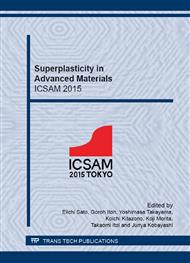[1]
W.M. Thomas, et. al., Friction Stir Butt Welding, International Patent Appl. No. PCT/GB92/02203 and GB Patent Appl. No. 9125978. 8, Dec. 1991, U.S. Patent No. 5, 460, 317.
Google Scholar
[2]
M.W. Mahoney, CG. Rhodes, J.G. Flintoff, R.A. Spurling and W.H. Bingel, Properties of friction-stir-welded 7075-T651 aluminum, Metal. Mater. Trans. A, 29A (1998) 1955-(1964).
DOI: 10.1007/s11661-998-0021-5
Google Scholar
[3]
R.S. Mishra and M.W. Mahoney, Friction stir processing: a new grain refinement technique to achieve high strain rate superplasticity in commercial alloys, Mater. Sci. Forum, 357-359 (2001) 507-514.
DOI: 10.4028/www.scientific.net/msf.357-359.507
Google Scholar
[4]
Z.Y. Ma, R.S. Mishra and M.W. Mahoney, Superplastic deformation behaviour of friction stir processed 7075Al alloy, Acta Mater., 50 (2002) 4419-4430.
DOI: 10.1016/s1359-6454(02)00278-1
Google Scholar
[5]
Y. Takayama, Y. Otsuka, T. Shibayanagi, H. Kato and K. Funami, Grain Refinement and High Temperature Deformation in Friction Stir Processed Sheets of Magnesium Alloys, Mater. Sci. Forum, 551-552 (2007) 55-60.
DOI: 10.4028/www.scientific.net/msf.551-552.55
Google Scholar
[6]
Z.Y. Ma, F.C. Liu, R.S. Mishra, Superplastic deformation mechanism of an ultrafine-grained aluminum alloy produced by friction stir processing , Acta Mater. 58 (2010) 4693–4704.
DOI: 10.1016/j.actamat.2010.05.003
Google Scholar
[7]
S. Pradeep, V. Pancholi, Effect of microstructural inhomogeneity on superplastic behaviour of multipass friction stir processed aluminium alloy, Mater. Sci. Eng., A561 (2013) 78–87.
DOI: 10.1016/j.msea.2012.10.050
Google Scholar
[8]
S.R. Babu, V.S.S. Kumar, L. Karunamoorthy, G.M. Reddy, Investigation on the effect of friction stir processing on the superplastic forming of AZ31B alloy, Mater. Design 53 (2014) 338–348.
DOI: 10.1016/j.matdes.2013.07.005
Google Scholar
[9]
O. Frigaad, O. Grong, O.T. Midling, A Process Model for Friction Stir Welding of Age Hardening Aluminum Alloys, Metall. Mater. Trans. A 33 (2001) 1189-1200.
DOI: 10.1007/s11661-001-0128-4
Google Scholar
[10]
M. Kokubo, Optimization of Welding Conditions in Friction Stir Welding of Dissimilar Aluminum Alloys, Doctoral dissertation, Utsunomiya University, Japan (2008).
DOI: 10.1201/9781315116815-4
Google Scholar
[11]
C. Leitao, R. Louro, D.M. Rodrigues, Using torque sensitivity analysis in accessing Friction Stir Welding/Processing conditions, J. Mater. Proc. Tech., 212 (2012) 2051-(2057).
DOI: 10.1016/j.jmatprotec.2012.05.009
Google Scholar


